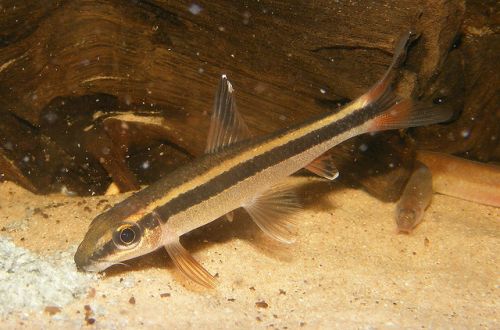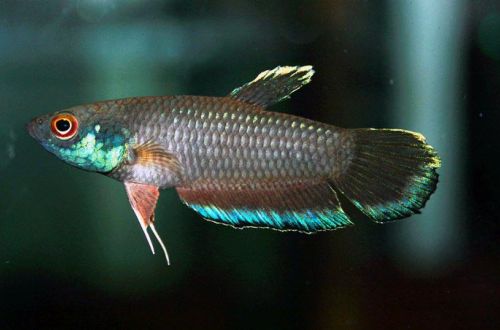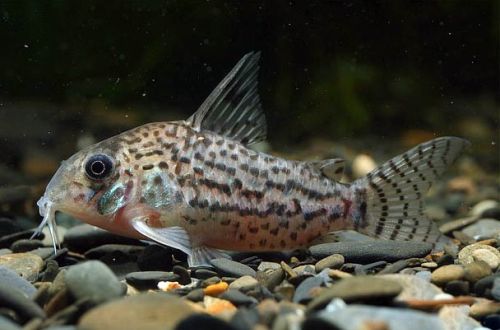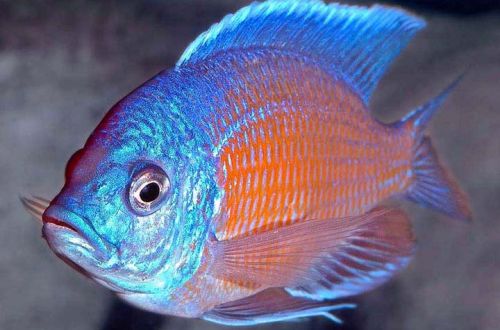
Epalceorhynchus
Epalzeorhynchos kalopterus, or Flying Fox, scientific name Epalzeorhynchos kalopterus, belongs to the Cyprinidae family. An active mobile fish, does not differ in its original color, however, it is popular among aquarists for its unpretentiousness and endurance. Often found in the aquarium trade.

Contents
Habitat
It comes from Southeast Asia, the Kalimantan Peninsula, the islands of Sumatra, Java. Inhabits areas of sandy or rocky shoals of small rivers and streams. During the rainy season, as river valleys and rainforests flood, fish temporarily move to new places in search of food.
Description
It has a narrow elongated body with a pointed head. Near the mouth there are four filiform processes of the antennae, with the help of which Epalceorhynchus probes the ground in search of small prey. The coloration is predominantly golden with a dark back. A wide dark stripe runs through the entire body, which begins near the mouth and stretches to the tail. Above the dark stripe is a luminous orange-red narrower stripe.
Food
In nature, they feed on algae and small vegetation that covers the surface of stones, snags, as well as small insects and crustaceans that live in it. In much literature, it is often erroneously described as a herbivorous species. However, meat products must be present in the diet. It is recommended to use high quality plant-based dry food (flakes, granules) with live/frozen/freeze-dried food (bloodworm, daphnia, brine shrimp). Pieces of vegetables and fruits are a great addition: cucumber, peeled zucchini, lettuce and spinach, apples. These pieces are attached with an elastic band, for example, to a stone, driftwood or other decor. Replace every two days to avoid unnecessary water contamination.
Maintenance and care
Unpretentious in care. You will need a spacious tank with a few decor items, a few boulders and driftwood will be enough. Plants of any kind, placed along the side and back walls of the aquarium to provide free space for swimming.
Water treatment is minimal, a neutral pH is preferred (all tap water is usually neutral). It is enough to collect the required volume and let it stand for a day, so that the remains of chlorine, which is used to disinfect water at water utilities, evaporate. The only difficulty is in a situation where the water is hard (dH indicator), in this case, special kits will be required to change the water parameters – they are reagents and tests (litmus papers, cones with a solution, etc.). there is a home way to make water soft – it must be boiled and cooled, all the salts will settle along with the scale.
Of the equipment, a filter, an aerator, a heater and a lighting system are needed.
Social behavior
Relatively peaceful species, when compared with the closest relative Labeo Green. Juveniles prefer to stay close to shelters. Adult fish lead a solitary lifestyle. They become territorial, occupy a certain area at the bottom of the aquarium and attack intruders. Particular aggression towards its own species and fish of a similar color and body shape. It is acceptable to keep in a single aquarium or some hardy cyprinids that live in the middle or upper layers of the water. Other benthic and especially territorial species are not recommended.
Reproduction / breeding
At home, breeding is unlikely, you need to take into account many factors and have a huge aquarium where the fish can get along together, catching each other’s eyes only during the spawning period.
Fish diseases
Health problems in a balanced aquarium are extremely rare. The main reasons are incorrect / inappropriate conditions of detention, poor nutrition. It is the latter that often leads to diseases, since often aquarists keep Epalceorhynchus exclusively on a plant-based diet, relying on erroneous articles. Read more about symptoms and treatments in the Aquarium Fish Diseases section.





